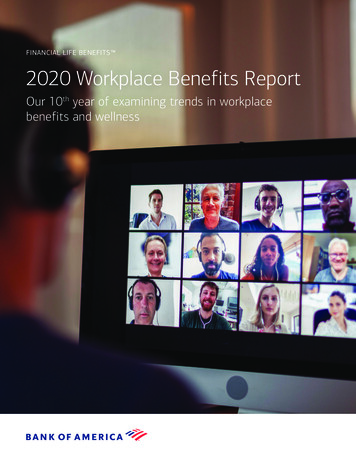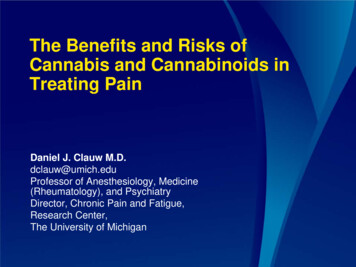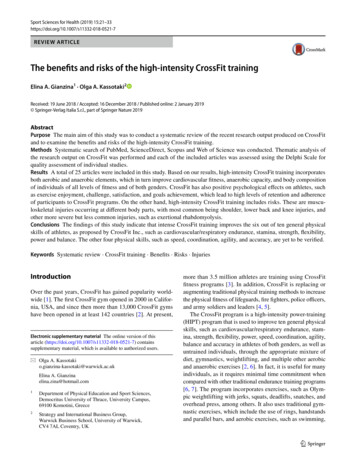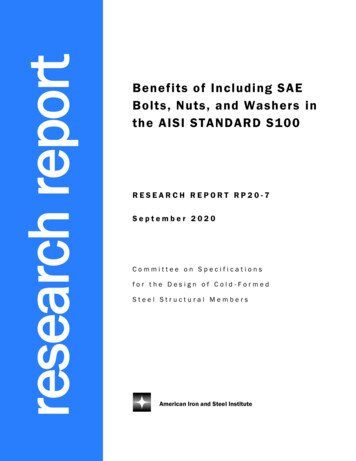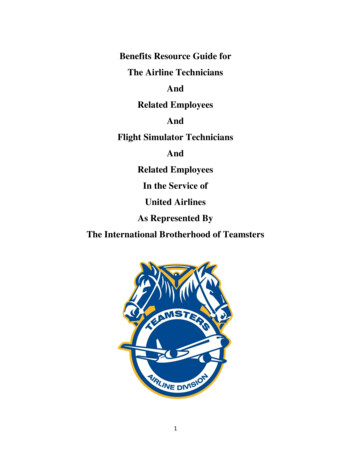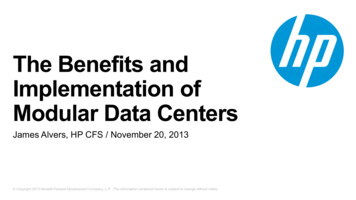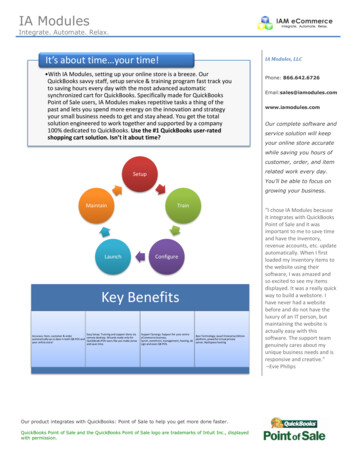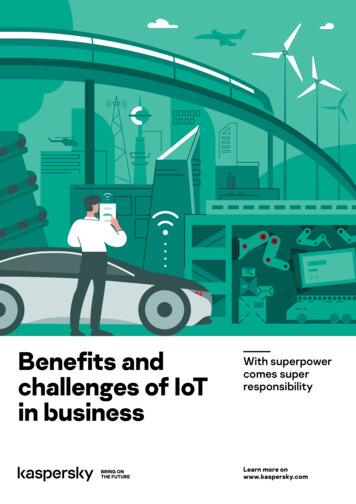
Transcription
Benefits andchallenges of IoTin businessWith superpowercomes superresponsibilityLearn more onwww.kaspersky.com
ContentsIntroduction1Key findingsMethodology22Superpowers demand responsibility:The collision of efficiency and privacy in IoTMore data, more efficiencySmart citiesIndustry and manufacturingThe question of privacy and data safetySuperpowers don’t come without challenges:What to prepare for when implementing IoTBusinesses are in clear need of IoT processesThe growing need for expertise at the junction of industrial processing and IoTWhat is important to know about IoT cybersecurity?Cybersecurity decision-makingIoT data and the cloudTakeaways for your IoT journey334458889101011
IntroductionThe use of Internet of Things (IoT) devices in business is growing at an exponentialrate. According to Gartner, the number of global IoT connections is expected to riseto approximately 25 billion by 2025.Simply put, IoT covers every device connected to the internet, fromwearables to industrial sensors. It is increasingly being used to defineconnected objects that ‘talk’ to each other through sensors with thecapacity to collect data and use it to make business more efficient andour lives easier.Initially suggested as a way to improve organizational processes,IoT devices have quickly become a way of enhancing our personallives as well. While this led them to gain popularity in devices suchas smartphones, watches and voice assistants, they still have a strongimpact in organizations.Here, connected devices impact nearly every business industry, withdevices including machine learning for predictive maintenance, smartgrid, sensors for shipping and logistics, automated manufacturingprocess, and connected HVAC (Heating, Venting, and Air Conditioning)systems among others. These allow for data collection, exchange andanalysis of many more touchpoints across the full set of businessprocesses.With the addition of large volumes of data from all these elements,businesses can gain actionable insights to help them better understandtheir workflow, drive productivity and increase efficiency – as wellas ultimately transform their business processes. As well as streamliningexisting businesses, organizations are able to consider potential newdirections, development of new products or services and expandinglines, all thanks to IoT capabilities.Yet, with this rise in connected devices also comes increased needfor security. Gartner has highlighted that nearly 20% of organizationshave already observed cyberattacks on IoT devices in the past threeyears. Because of their levels of connectivity and access to businessnetworks, IoT systems increase the potential cyberattack surfaceat any organization. Therefore, the most important considerationfor organizations looking to introduce IoT devices into their businessprocesses is to ensure they provide strong IoT system security.As IoT solutions increasingly emergein businesses, industry and evenlocal government, the need forincreased security is set to grow.Therefore it’s vital that organizationsraise their levels of awarenessin IoT security and the abilityto mitigate risk.This report helps technology suppliers, service providers, organizationsand security professionals who are planning (or already implementing)IoT systems to understand the growing IoT landscape. It looks at therange of opportunities that IoT offers for organizations, along with thechallenges these new systems present. It also provides cybersecurityrecommendations for IT security professionals to follow, to make themost of their IoT platform and secure it from potential data breachesand attacks on the whole network.1
Key findings1The use of IoT is already widespread across a range of business industries: 61% of organizationsare currently using IoT platforms in their business.2IoT use is even higher in the IT and telecoms industry (71%) and finance (68%)3The growing rate of IoT increases the business need for data protection and prevention fromcyber-incidents. In the first half of 2019, Kaspersky researchers detected 105 million attackson IoT devices through honeypots.4Nearly three-in-ten (28%) companies using IoT platforms experienced incidents involving noncomputing connected devices in the last year.5The reliability of suppliers is no less important, with more than a third (36%) of companies givingthird parties access to their IoT platforms.MethodologyThe findings in this report are taken from several sources including:the Kaspersky Global Corporate IT Security Risks Survey – formedof a total of 4,958 interviews with IT business decision makers,conducted across 23 countries in 2019; Kaspersky’s threat researchinto attacks on IoT devices through honeypots and Kaspersky ICS CERTresearch on the threat landscape for smart buildings; and Kaspersky’ssecurity assessment of corporate information systems report.In addition, statistics are included from third party sources, includingGartner, IDC and GSMA, and Cybersecurity Insider reports.2
Superpowers demand responsibility:the collision of efficiency and privacy in IoTMore data, more efficiencyThe role of IoT in business has grown rapidly in recent years. Today,IoT systems can be used to introduce cost reduction and savingsto businesses, as well as unlock new revenue streams and makeproduction processes more transparent.According to Kaspersky’s survey, 61% of organizations currently useIoT platforms as business applications. In fact, there are actually severalindustries where their use of IoT is even higher: 71% of those in the ITand telecoms industry use IoT, while 68% of those in the finance worldfollow suit. Meanwhile, at utility and power companies, this figure is twothirds of businesses (66%).Year-on-year use of IoT platforms by industry71%68%66%64%60%58%59% 58%56%60%63%Government20182019IT ial andmanufacturingRetail andwholesaleHospitalityUtilities andpowerTable 1: in what industries IoT platforms are used — year-on-year split,Kaspersky Global Corporate IT Security Risks Survey 2019Notably, total IoT spending is set to reach 1.1 trillion by 2025, jumpingby a huge 567% up from 166 bn in 2016, according to forecastsfrom GSMA and IDC. This impressive growth is likely due to the widerlevels of use of IoT across business, industry and sectors such as cityplanning. In fact, we are already starting to see IoT used for connectedtransportation, industrial automation, the automotive industry, the widerdeployment of smart city initiatives and more.3
Smart citiesSingapore is one example of a cityaiming to transform the qualityof living through technology.In recent years, it has implementedroad sensors that connect tophased traffic lights and smartparking systems, leading tosignificant improvements in trafficmanagement.According to IoT Analytics, the number one growth area for all IoTprojects globally is in the use of smart cities. In smart cities, localauthorities can utilize connected IoT devices to introduce systems suchas street lights, smart parking and smart utility meters for offices andhouseholds. The prospect of IoT systems widens from simply runningutilities management for residents and lighting controls to criticalservices such as transportation management, traffic control and videosurveillance.Meanwhile, Barcelona is aimingto tackle city-wide environmentalconcerns though smart streetlightsand sensors monitoring air qualityand noise, which connect to smartgrid pilot projects and smarthousehold meters.One of the main triggers for this growth of IoT in smart city projects isthe need for cost reduction. Being able to monitor and optimize publicsystems and services through smart devices allows local authoritiesto best utilize resources, such as energy or water, helping to save moneyacross these new developments.In addition, the growing penetration of 5G, one of the most discussedtopics in tech right now, will also enable significant growth of IoT in smartcities as it rolls out higher network bandwidth.This promised high speed wireless technology will enable thetransportation of far larger volumes of data and reduce response timeacross mobile networks – all allowing for the wider use of IoT applicationsand the transfer of data from city-wide smart sensors.In Europe, 45 new ‘5G trial cities’ are expected to be launched in 2020,including London, Ghent, Paris and Berlin, to host and demonstrate usecases for the technology. They will begin implementing 5G across vasturban locations to test the potential for development in smart cities, suchas in energy, transport, smart buildings and digital-health platforms.Despite these trials, the full implementation of 5G mobile networks ata national, or city level, may take longer than telecoms providers originallypredicted. China for example, currently one of the most advanced5G nations, now estimates a time frame rising to 2030 for the finaldevelopments of a country-wide 5G network.Industry and manufacturingBut it’s not just in futuristic smart cities where IoT is leading to businessefficiencies. Thanks to the intelligence and monitoring that IoT devicesoffer, industrial organizations can gain increased transparency and theopportunity for automation, or predictive maintenance.In Industrial IoT (IIoT) technology, sensors can be attached to machines.During the manufacturing process, those sensors gather data, analysisof which helps manufacturing owners take action.The World Economic Forum recently recognized a number of organizationsit considers “beacons of technology and innovation in manufacturing”.Each of them use an IIoT infrastructure to advance their businessprocesses, including big data decision-making, democratized technologyon the shop floor and new business models. One of these recognizedorganizations, Tata Steel, uses IoT sensors across its IJmuiden plant in theNetherlands to solve industrial problems. Analysis of this data has helpedthe organization optimize the way it uses raw materials, increase its yieldand find solutions for waste reduction across the manufacturing process.4
“Digital transformation is about transforming an entire business from the culture to the strategyto the goals. IoT, and especially Industrial IoT (IIoT), is critical to digital transformation acrossindustries. The Precision Crop Management Testbed is an example of this transformation, whichuses IoT technology (sensors) to improve crop productivity (yield),” commented Dr. Richard Soley,Executive Director, Industrial Internet Consortium.Interestingly, in the case of IIoT, one main engine driving smart projectsis manufacturing equipment vendors who are looking to providetransparent, efficient processes to their customers. Thanks to IoT smartmetering, they are able to run visible product lifecycle management whichshows how each piece of equipment is being utilized. Based on this datathey can then offer new ways of manufacturing optimization, such asdetecting abnormal patterns in an asset’s performance or establishingwhere in a workflow the productivity drops, and why.On top of this, vendors can now offer their customers new solutions suchas ‘equipment as a service’ — where a customer pays based on workingcycles or productivity, instead of buying or renting the equipment itself.The question of privacyand data safetyBecause of their connected nature, IoT systems involve manycomponents which vendors and third-parties may need to access. Forexample, in smart city projects, systems such as traffic controls, CCTVand even utility supplies to apartments, store many different typesof personal user data. Therefore, it’s important that the smart systemis configured and protected to ensure this data cannot be unlawfullyaccessed.According to Kaspersky research, 36% of companies admit that thirdparties have access to their IoT platforms. This is higher than for manyother elements of business infrastructure, such as office productivitysoftware (23%), email (27%) or enterprise resource planning (ERP; 30%).One notable case illustrates why connections with third parties shouldbe given consideration in terms of data security. In 2019, KasperskyICS CERT experts conducted research into threats to smart buildingautomation systems. The findings show that on 38% of computersin the automation systems of smart buildings, malicious objects weredetected and blocked.5
Access to business applicationsby third partiesIoT platformsBig data processing applicationsEnterprise file synchronization and sharingCommerce / trading softwareERPEmailOffice productivity softwareTable 2: what business applications are accessed by third parties,Kaspersky Global Corporate IT Security Risks Survey 2019Among the attack vectors researchers found a remarkable instance ofone conducted through a contractor that supplies building automationsystems to different organizations. An attack to this contractor withbackdoors and spyware would allow threat actors to gain remote accessto facilities where these systems are being used, such as smart buildingsystems in airports, transportation hubs or office buildings.As well as ensuring the reliability of third parties who have access to IoTsystems, it is important for organizations to think about the security ofthese devices. This is highlighted by the 28% of companies using IoTplatforms who stated that they experienced incidents involving noncomputing connected devices in the last year. This is higher than thoseaffected by crypto-mining attacks (26%), incidents involving datasharing suppliers (27%) and infrastructure incidents involving thirdparties (27%).Given their connected nature, IoT platforms unite many differentdevices on one network, each of which can become an entry point foran attack, causing the overall attack surface to widen. Therefore it isimportant for businesses and IT security professionals to consider thechallenges and concerns that may arise with IoT implementation, as laidout in the next section of this r
Key findings Methodology The findings in this report are taken from several sources including: the Kaspersky Global Corporate IT Security Risks Survey – formed of a total of 4,958 interviews with IT business decision makers, conducted across 23 countries in 2019; Kaspersky’s threat research
